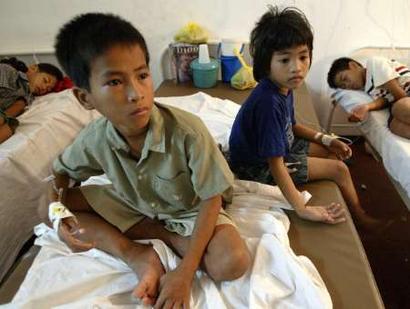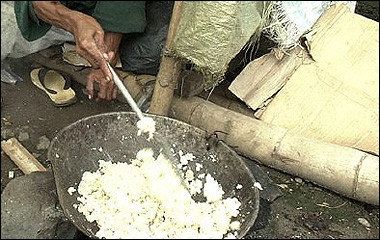|
27 children die after eating cassava at Philippine school
(Agencies)
Updated: 2005-03-10 09:40
Wailing parents carried the bodies of their children from hospitals after a
snack of cassava killed 27 and sickened 100 others Wednesday at an elementary
school in south-central Philippines.
With the nearest hospital 30 kilometres away from San Jose school, in Bohol
island's Mabini town, some victims died while being carried in a variety of
vehicles, including three-wheel motorcycle taxis.

Filipino school
children lie in the hospital in Ubay town of Bohol, province March 10,
2005. More than 100 people were poisoned after eating during a snack break
at school. At least 27 pupils at San Jose Elementary School in Magini,
Bohol, Philippines died of likely cyanide poisoning on Wednesday after
eating carmelized cassava
roots. [Reuters] | Francisca Doliente said
her nine-year-old niece, Arve Tamor, was given some of the deep-fried
caramelized cassava by a classmate who bought it from a vendor outside the
school.
"Her friend is gone. She died," Doliente said. Her niece was being treated,
she said.
The roots of the cassava plant, a major crop in the tropical countries, are
rich in protein, minerals and vitamins. However, cassava is poisonous unless it
is peeled and thoroughly cooked. If it is eaten raw or prepared incorrectly, one
of its chemical constituents will be attacked by digestive enzymes and give off
the deadly poison cyanide. As little as two cassava roots can contain a fatal
dose.

Grated
cassava. Philippines President Gloria Arroyo was expected to condole with
the villagers after poisonous cassava sweets killed up to 27 children and
sent around 60 others to hospital, officials said.
[AFP/File] | "Some said they took only two
bites because it tasted bitter and the effects were felt 5-10 minutes later,"
said Dr. Harold Gallego of Garcia Memorial Provincial Hospital in the nearby
town of Talibon, where 47 patients were taken.
Mabini Mayor Stephen Rances said 27 students were confirmed dead.
The victims suffered severe stomach pain, vomiting and diarrhea. They were
taken to at least four hospitals from the school in Mabini, about 600 kilometres
southeast of the capital, Manila.
Sobbing parents left hospitals carrying the bodies of their children wrapped
in blankets.
Some victims were still vomiting nearly 12 hours after eating the snack, said
Dr. Nenita Po of the government-run Gov. Celestino Gallares Memorial Hospital.
However, those who were alive when they reached the hospital had a good chance
of surviving, Po said.
He said some worried parents brought in their children even if they did not
show any symptoms of poisoning.
Grace Vallente said her seven-year-old nephew Noel died en route to the
hospital and that her nine-year-old niece Roselle was undergoing treatment.
"There are many parents here," she said from L.G. Cotamura Community Hospital
in Bohol's Ubay town. "The kids who died are lined up on beds. Everybody's
grief-stricken."
Dr. Leta Cutamora confirmed 14 dead at the hospital and 35 admitted for
treatment.
Po said 15 patients were brought there, including the 68-year-old woman who
prepared the cassava along with another woman. Officials wanted to talk with the
ailing woman, but said she was complaining of pain.
A specimen of the cassava was taken for inspection at the local Crime
Laboratory Group.
| |
 |
|
 |
|
|
Today's
Top News |
|
|
|
Top World
News |
 |
|
 |
|
|
|
|
|
|


